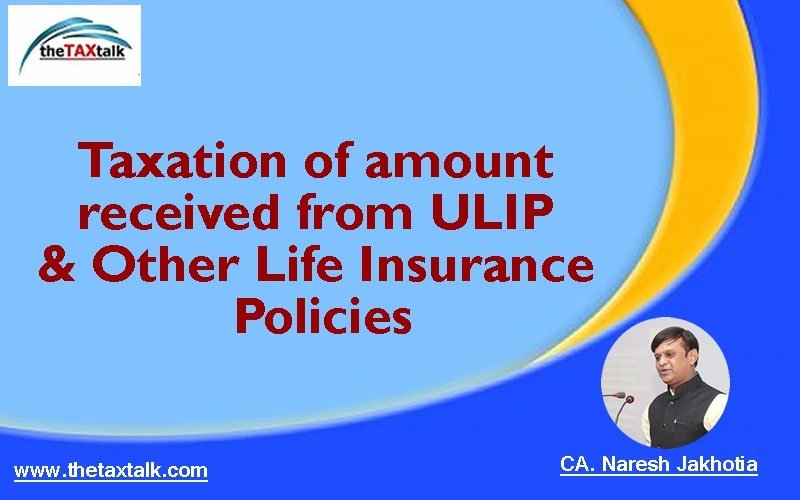![]()
Taxation of amount received from ULIP & Other Life Insurance Policies
Any amount received on surrender or maturity of the life insurance policies is tax free is one of the most common presumptions of the taxpayers. This is not entirely correct. Though the amount received (including bonus) is tax free u/s 10(10D) of the Income Tax Act- 1961, it is not so in the following cases:
(a) any sum received u/s 80DD(3) or u/s 80DDA(3); or
(b) any sum received under a Keyman insurance policy; or
(c) Any sum received in respect of any policy issued:-
(i) between 01.04.2003 to 31.03.2012, if the premium in any years exceeds 20% of the actual capital sum assured
(ii) After 01.04.2012, if the premium in any years exceeds 10% of the actual capital sum assured. However, if the policy is issued for the life of a person with specified disability or person suffering from specified diseases then 10% needs to be replaced by 15%. [No tax impact would be there if such amount is received on the death of a person].
In short, the amount received from life insurance policies will not be tax free if the amount is received from insurance policies wherein the premium was exceeding 20% or 10% or 15% of the sum assured. Similar condition is also there for allowing deduction u/s 80C on such policies at the time of payment. The deduction is available only if premium is within the limit of 20% or 10% or 15% as referred above.
Taxation of ULIP Policies vis a vis Amendment by the Finance Act-2021 restricting the benefit of exemption in respect of amount invested in ULIP to Rs. 2.50 Lakh:
Unit Linked Insurance Plan (ULIP) is a hybrid investment option given by the life insurance companies which is a combo of insurance and investment. The premium taken by the insurance company is partly towards the life insurance of policy holders & partly towards the investment.
Earlier, subject to the conditions discussed at (a) to (c) above, any amount received from ULIP was fully exempt u/s 10(10D). However, the benefit has been restricted by the Finance Act-2021 by providing that exemption shall not be available in the following cases:
a) If only one ULIP Policy is taken:
In such a case, tax exemption shall not be available if the amount of premium payable on the ULIP issued on or after 01/02/2021 exceeds Rs. 2.50 Lakh in any year during the term of ULIP policy.
b) If multiple ULIP Policy is taken:
In such a case, exemption shall be available only if the aggregate premium payable by a person for any of the ULIPs issued or after 01/02/2021 does not exceed Rs. 2.50 Lakh in any of the year during the term of any of those ULIPs. Further, if the aggregate of premium of all such ULIP policies exceeds Rs. 2.50 Lakh then the exemption shall be restricted to the policies of Rs. 2.50 Lakh.
How is the income computed and Tax payable in case of ULIP policies which are not tax free?
ULIP policies which are not eligible for exemption u/s 10(10D) as discussed above will be considered as “Capital Assets” and will be treated as Units of an Equity Oriented Fund. It will be taxable under the head “capital Gain” in the year in which such amount is received.
- The computation of income is required to be done as under:
a) Sum is received from one ULIP only wherein the amount of investment in any year exceeds Rs. 2.50 Lakh:
In such a case, the entire amount received less amount invested therein shall be taxable. No indexation benefit is available for the invested amount.
b) Sum is received from multiple ULIPs :
In such a case, taxpayers shall be eligible to claim the exemption for all ULIPs if the aggregate of premium payable on such individual ULIPs does not exceed Rs. 2.50 lakh in any year during their policy term & aggregate amount of all the ULIP is not exceeding Rs. 2.50 Lakh. If the aggregate of premium payable on all ULIPs exceeds Rs. 2.50 Lakh in any of the years, then the consideration received from only those ULIPs shall be exempt whose aggregate premium payable does not exceed Rs. 2,50,000/-. For example, Mr. Smart has taken three ULIP policies for Rs. 1.50 Lakh, Rs. 75,000/- & Rs. 1 Lakh after 01.04.2021. In the case of Mr. Smart, the taxpayer can choose two policies up to Rs. 2.50 Lakh to claim an exemption U/s 10(10D).
- Indexation Benefit:
The taxation mechanism has been specifically provided in section 45(1B) read with Rule 8AD as a result of which the indexation benefit is not available on taxation of ULIP policies. - Tax Rate:
Depending upon the period of investment in ULIP Policy, it will be classified as short term or long term capital assets. It will be taxable as per the rates provided u/s 111A (15% plus applicable surcharges & cess) if the ULIP is considered as Short Term Capital Assets or U/s 112A (10% plus applicable surcharge & cess on amount above Rs. 1 Lakh) if the ULIP is considered as Long Term Capital Assets. - The sums received on account of death of insured will still continue to be exempt from tax.
- TDS U/s 194DA:
To track the taxability of such transactions, section 194DA provides for deduction of tax @ 1% (20% if no PAN) of sum paid under a life insurance policy which is not eligible for exemption u/s 10(10D) if aggregate sum paid in a financial year is Rs. 1 Lakh or more. In short, if the TDS credit statement (Form 26AS) of the taxpayers reflects TDS U/s 194DA, one can be sure that amount is taxable. However, one needs to carefully note that Rs. 1 Lakh limit is there for TDS u/s 194DA & not for 10(10D).


